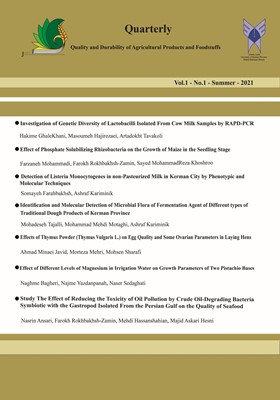Identification and Molecular Detection of Microbial Flora of Fermentation Agent of Different types of Traditional Dough Products of Kerman Province
Subject Areas : Shelf Life of Food Products and Agricultural ProductionsMohadeseh Tajalli 1 , Mohammad Mehdi Motaghi 2 * , Ashraf Kariminik 3
1 - M.S, Department of Microbiology, Kerman Branch, Islamic Azad University, Kerman, Iran
2 - Assistant Professor, Department of Microbiology, Kerman Branch, Islamic Azad University, Kerman, Iran
3 - Assistant Professor, Department of Microbiology, Kerman Branch, Islamic Azad University, Kerman, Iran
Keywords:
Abstract :
Sourdough microflora generally contains yeast and lactic acid bacteria, and the interaction of microorganisms for its metabolic activity is important. Lactic acid bacteria produce numerous metabolites such as organic acids, enzymes, and exopolysaccharides during sourdough fermentation, which have a positive effect on the structure of the dough and bread's texture and staling. This study aimed to identify and compare the microbial flora of traditional bread dough in different cities of Kerman province by culture and molecular methods. MRS culture medium and Sabouraud Dextrose Agar were used in order to isolate lactic acid bacteria and yeasts respectively. Biochemical and antimicrobial tests were performed. 4 isolates of bacteria and 4 isolates of yeasts were identified by molecular method and comparing the resulting sequences of the sequences in the gene bank, respectively. Bacterial species were Weissella cibaria, Acinetobacter baumannii, Pediococcus pentosaceus, and Staphylococcus gallinarum, and yeasts Saccharomyces cerevisiae and Candida tropicalis. Based on the results, the microorganisms identified in this study can be suggested to improve the quality of bread and create a better taste and aroma of bread.
1-Sakandar HA, Hussain R, Kubow S, Sadiq FA, Huang W, Imran M. Sour-dough bread: A contemporary cereal fermented product. Journal of Food Pro-cessing and Preservation. 2019;43(3): e13883. 2-Gänzle MG, Zheng J. Lifestyles of sourdough lactobacilli-Do they matter for microbial ecology and bread qua-lity?. International journal of food micr-obiology. 2019;302:15-23. 3-De Vuyst L, Van Kerrebroeck S, Harth H, Huys G, Daniel HM, Weckx S. Microbial ecology of sourdough ferme-ntations: diverse or uniform?. Food microbiology. 2014;37(1):11-29. 4-Plessas S. Innovations in Sourdough Bread Making. Fermentation. 2021; 7(1):29. 5-Lin XB, Gänzle MG. Quantitative high-resolution melting PCR analysis for monitoring of fermentation micro-biota in sourdough. International journal of food microbiology. 2014;186(1):8-42. 6-Bartkiene E, Lele V, Ruzauskas M, Domig KJ, Starkute V, Zavistanaviciute P, Bartkevics V, Pugajeva I, Klupsaite D, Juodeikiene G, Mickiene R. Lactic acid bacteria isolation from spontaneous sourdough and their characterization including antimicrobial and antifungal properties evaluation. Microorganisms. 2020;8(1):64. 7-Alfonzo A, Ventimiglia G, Corona O, Di Gerlando R, Gaglio R, Francesca N, Moschetti G, Settanni L. Diversity and technological potential of lactic acid bacteria of wheat flours. Food micro-biology. 2013;36(2):54-343. 8-Reddy G, Altaf MD, Naveena BJ, Venkateshwar M, Kumar EV. Amy-lolytic bacterial lactic acid fermen-tation-a review. Biotechnology advan-ces. 2008;26(1):22-34. 9-Saeedi V. Investigation of microbial biodiversity of three types of sourdo-ughs native to Isfahan region. 2011; Master Thesis. School of Agriculture. Isfahan University of Technology. 10-Tafti AG, Peighambardoust SH, Hejazi MA. Biochemical characterize-ation and technological properties of predominant Lactobacilli isolated from East-Azarbaijan sourdoughs (Iran). Inte-rnational Food Research Journal. 2013; 20(6):3293. 11-Vera A, Rigobello V, Demarigny Y. Comparative study of culture media used for sourdough lactobacilli. Food microbiology. 2009;26(7):33-728. 12-Venturi M, Guerrini S, Granchi L, Vincenzini M. Typing of Lactobacillus sanfranciscensis isolates from traditi-onal sourdoughs by combining conve-ntional and multiplex RAPD-PCR prof-iles. International journal of food micr-obiology. 2012;156(2):6-122. 13-Sterr Y, Weiss A, Schmidt H. Evalu-ation of lactic acid bacteria for sour-dough fermentation of amaranth. Inter-national journal of food microbiology. 2009;136(1):75-82. 14-Lattanzi A, Minervini F, Di Cagno R, Diviccaro A, Antonielli L, Cardinali G, Cappelle S, De Angelis M, Gobbetti M. The lactic acid bacteria and yeast microbiota of eighteen sourdoughs used for the manufacture of traditional Italian sweet leavened baked goods. Intern-ational Journal of Food Microbiology. 2013;163(2-3):9-71. 15-Nuobariene L, Cizeikiene D, Gradze-viciute E, Hansen ÅS, Rasmussen SK, Juodeikiene G, Vogensen FK. Phytase-active lactic acid bacteria from sourd-oughs: Isolation and identification. LWT-Food Science and Technology. 2015;63(1):72-766. 16-Lhomme E, Lattanzi A, Dousset X, Minervini F, De Angelis M, Lacaze G, Onno B, Gobbetti M. Lactic acid bacterium and yeast microbiotas of sixteen French traditional sourdoughs. International Journal of Food Micro-biology. 2015;215:70-161. 17-Nionelli L, Curri N, Curiel JA, Di Cagno R, Pontonio E, Cavoski I, Gobbetti M, Rizzello CG. Exploitation of Albanian wheat cultivars: characteri-zation of the flours and lactic acid bacteria microbiota, and selection of starters for sourdough fermentation. Food microbiology. 2014;44(1):96-107. 18-Rasool SMS, Nateghi L, Lavasani ASH, Estiri SH. Effect of Sourdough Containing Lactobacillus paracasei and fermentum on Physicochemical Proper-ties and Shelf life of Barbary Bread. Journal of Innovation in Food Science and Technology. 2019;11(2):1-4. 19-Valerio F, Bavaro AR, Di Biase M, Lonigro SL, Logrieco AF, Laverm-icocca P. Effect of amaranth and quinoa flours on exopolysaccharide production and protein profile of liquid sourdough fermented by Weissella cibaria and Lactobacillus plantarum. Frontiers in Microbiology. 2020;21(11):967.
_||_
